Do You Want to Learn How to Play Bingo, Balderdash, and More?
 If you want to learn to play party games like Bingo (also known as Lotto, in some circles), read on. I’ll explain how to play Bingo, Balderdash, Pictionary, Taboo, Guesstures, Quelf, Apples to Apples, and Dixit below.
If you want to learn to play party games like Bingo (also known as Lotto, in some circles), read on. I’ll explain how to play Bingo, Balderdash, Pictionary, Taboo, Guesstures, Quelf, Apples to Apples, and Dixit below.
These popular party games are widely available. Some, like Bingo, are quite old while others, like Dixit, are relatively new to the gaming scene.
Let’s get started with what you need to play Bingo and what the normal rules of the game are.
What Are the Requirements for Bingo?
Bingo equipment comes in various shapes and sizes. The minimum items you need are Bingo cards, letter-number tokens, and something to mark which numbers have been called.
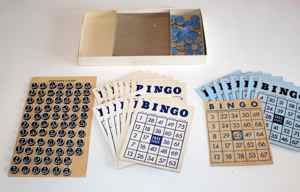 Each player can have more than one card per game, so you need enough Bingo cards for person to play with several, unless you are going to limit everyone to just one card. Most Bingo sets come with plenty of unique cards, so if you’re using a complete set, you shouldn’t have a problem.
Each player can have more than one card per game, so you need enough Bingo cards for person to play with several, unless you are going to limit everyone to just one card. Most Bingo sets come with plenty of unique cards, so if you’re using a complete set, you shouldn’t have a problem.
Cards often show a 5 by 5 grid of numbers with the letters B, I, N, G, and O across the top of the columns. The center space is usually a free space, meaning it counts as if the number that would have been there was called before the game began.
Some sets have a different arrangement. I’ve seen cards for a Lotto game that show a grid of 3 rows and 9 columns. Each row has 5 numbers and 4 blank spaces. (I’m not sure why the designers didn’t just make the cards with only 5 columns.) These cards did not have any “guide letters” across the top.
The letter-number (or just number) tokens are sometimes disks that you can draw from a bag or shake from a box. Other times they are balls that you spin in a bin that has a cup to catch one of them as it rotates.
After a number is selected and called, you must do something to mark your card, if it shows the called number. If you are not planning to reuse the cards, you can use a marker to highlight or cross off the number. More likely, you will use a plain cardboard or plastic token of some sort to cover up the number temporarily.
How Many Players Can Play Bingo at Once?
To play Bingo properly, you really should have at least three people, but the more, the merrier. One person does selecting and calling of the numbers and nothing else. He is thus an impartial judge who can verify the winner’s card when the game is over.
The number of actual players is limited only by the number of cards in your set. For example, if you have 50 cards (and enough physical space for everyone), you could have 50 players. If you allow everyone to have two cards, you could have as many as 25 players.
Some sets of rules even suggest that each player gets three cards. In that case, you would probably be limited to about a dozen players realistically, assuming you’re just playing at home.
Formally organized Bingo games are usually played in large public halls that can accommodate a large number of players. These normally require an entry fee and have a cash payout for the winner(s).
What Are the Actual Rules for Bingo?
The rules for Bingo (and Lotto) are quite simple. The caller randomly obtains a number, speaks it aloud for all to hear, and sometimes places is on a tracking chart for easy reference at the end of the game.
As a player, you scan your card(s) for the called number and mark it off (with a token) to indicate that you heard it. When you have filled all five space in any row or column, you call “Bingo!” and the game ends, assuming you correctly marked your card.
Most people allow a bingo if you fill all four corners of your card as well. The free space in the center theoretically is your fifth called number. As I hinted at earlier, this center free space also means that you only need four numbers to fill the middle column or the middle row of your card.
When someone calls a bingo, the caller checks that the card was filled properly. If so, that player is the winner. Players often play more than one game in a row, sometimes with the caller rotating to a new person for the next game.
How Do You Play Balderdash?
Balderdash is extremely close to the generic parlor game of the 1800s usual known as the dictionary game. Balderdash replaces the dictionary with a pack of word cards (sometimes with categories) and adds a scoring track mainly used to limit the time spent playing the game.
The basic premise is this. The leader (Dasher) selects a word that is (hopefully) unfamiliar to everyone playing. Everyone except the leader secretly writes down a phony, but realistic, definition of that word and initials it. The Dasher write downs the actual definition.
All definition papers are collected and shuffled. The leader reads them all, and players decide which one they believe is the true definition. Then the true one is revealed.
If you picked the correct one, you get points. The leader gets points if no one guessed the correct one. You get points if anyone chose your made-up definition. The first player to get to the end of the score track wins. Some versions have special spaces along the way that award double points.
How Do You Play Pictionary?
Pictionary is a team game, so you need at least 4 players. You divide your group into two or more (roughly) equal teams. The first sketcher on the first team draws a card with a word on it based on the category shown on the scoring track. He tries to get the rest of his team to say that word based solely on what he draws with a pencil on paper.
Unless “All Play” is designated, either on the card or the board, only one person draws at a time, and only one team tries to guess what is being drawn.
If the word is guessed within the time limit set by a sand timer, the team rolls a die to determine how far to move along the track. The same team continues to play, with someone else as sketcher, as long as they keep guessing correctly within the time limit. When a team fails, the turn passes to a new team.
When someone reaches the final “All Play” space, that team must be first to guess correctly on their own turn to win.
How Do You Play Taboo?
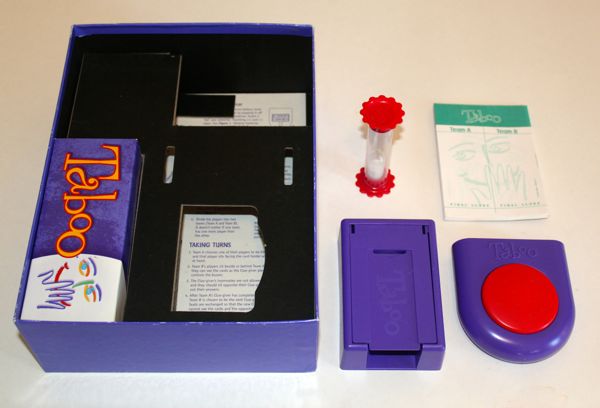
Taboo is a word guessing game. Divide your group into two teams. Designate one player on your team to be the one to give clues for a word at the top of a card. That player tries to get the rest of the team to say the word within the time limit, but he may not use gestures or say any of the other five words in the list on the lower section of the card. Someone on the opposing team also looks at the card and hits a buzzer if the clue giver mistakenly uses one of those forbidden words.
The clue giver tries to get through as many cards as possible before time runs out. He can pass on any card, but that (and buzzed words) will award points to the opposing team.
When each person on both teams has had a chance to be the clue giver, the game ends, points are tallied, and the team with the most points wins.
How Do You Play Guesstures?
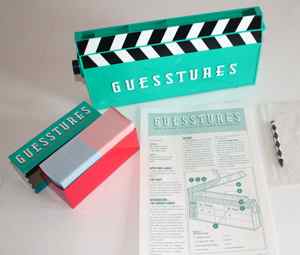 Guesstures
Guesstures is very similar to the traditional game of charades. Guesstures adds a time limit, a card holding device, and cards with difficulty levels and point values.
This is another team game, so you need at least four people to play. The clue giver selects four cards and places them into slots along the top of the holder. When the time on the holder starts, he will have about a minute to get his team to guess the four words in order.
One catch is that each card will drop down into the holder after a few seconds. The clue giver must grab the before after his team guesses the word and before the holder takes it away from him. Failing this, he moves on the to next card and continues the charade.
Each player on each team gets a chance to give the clues. When everyone is done, points are totaled, and the team with the most wins. Some versions also award two points to the last team to get all four words in a round.
How Do You Play Quelf?
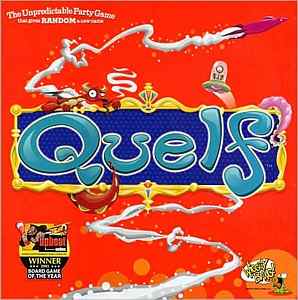
Quelf has a board and decks of cards that match the spaces on the board. Your goal is to get to the last space on the board by doing what the cards say.
It’s not that simple.
Here are some examples (paraphrased from a review on Board Game Geek) of what the cards might tell you to do.
Green cards ask trivia questions. “What does the Pythagorean theorem pertain to?” For a bonus draw a car using nothing but the shape that pertains to that theorem.
Red cards make all players give answers about a particular topic. “Name a character from Lord of the Rings or a Reason why you broke up with your ex”. You go around the table until someone repeats an answer or can’t answer the question.
Yellow cards require you to do a Stunt. “Declare you are brilliant and then place your head on the table and do not speak. Stay this way till your next turn. Bonus if someone touches you then you are free and the player who touches you advances 3 spaces.”
Purple cards are called showbiz cards. “Using your nose as a trumpet, play the National Anthem. If someone saluted you or placed their hand over their heart they move ahead 2 spaces.”
Blue cards are special rule cards. A rule card could affect just you or everyone playing. “You have no arms. From now on unless involved in another card action you must have other people pick up your card, feed you, etc.”
Penalties doled out from failure to perform certain actions could force you to move your token backward on the board. Interaction of players and cards is frequent, so you must often be thinking about several conditions at the same time causing you to forget one or more of them resulting in these penalties.
Eventually someone will get to the end of the track on the board or you’ll simply decide to quit the game by consensus.
Find versions of Quelf at Amazon.
How Do You Play Apples to Apples?
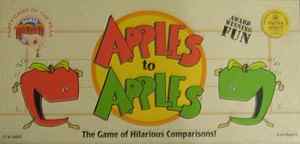
Apples to Apples is a party game that plays best with about half a dozen people. There are two decks of cards – one for players’ hands and the other for the judge.
Each player has a hand of seven cards from the one deck with various words or short phrases on them. The judge (also a regular player when he’s not judging) flips a card from the other deck.
Players then quickly place a card from their hands face down on the table. The last person to place a card must put it back into his hand and does not participate in the rest of the round.
The judge then reveals the players’ cards and determines which one best matches the original card that he had flipped. Players are encouraged to plead the case for their card with the judge because, if he picks theirs, they win the round (claiming the flipped card as a prize).
The person to the left of the current judge becomes judge for the next round. Play continues until one player has won a predetermined number of cards / rounds.
See several Apples to Apples editions at Amazon.
How Do You Play Dixit?
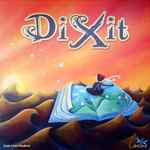
Dixit has similarities to Apples to Apples and Balderdash. You have a hand of cards, but they have unusual colorful drawings instead of words.
One player says something from a single word to a short story that describes one of his cards and hopefully will connect with one or two other players. Each player then plays a card face down that he thinks matches what that player has said.
The storyteller shuffles and reveals the cards. Players vote on which card they think is the correct one.
If nobody or everybody selects the correct card, the storyteller scores zero, and everyone else scores two. Otherwise the storyteller and whoever found the correct answer score three. Players score one point for every vote for their own card.
The game ends when the deck is empty or a player scores 30 points.
